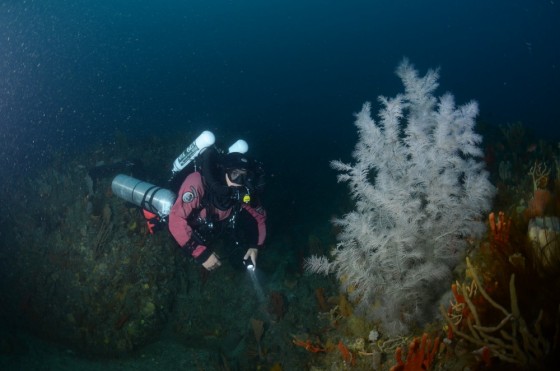Where
Joe's reef in the Freycinet Marine Park, 6 nautical miles offshore from Bicheno, Tasmania.
Who
Dr Neville Barrett (IMAS), Mr James Parkinson and Dr Andreas Klocker (members of the Tasmanian Scuba Diving Club (TSDC))
When
October 2015
Why
Little is known about marine habitats that lie beyond conventional diving depths of about 40 metres. While autonomous underwater vehicles (AUVs) are often used to document habitats of deeper reefs, these AUVs are limited by low-resolution cameras and their pre-programmed paths underwater. The only way to have a closer look at these habitats is to use technical divers capable of diving below conventional depths, using rebreathers and mixed gases.
How
Scientists from the Marine Biodiversity Hub were using multibeam sonar to map the seafloor in 2011 when they discovered an unusual deep reef off the coast of Bicheno. To obtain a better understanding of this newly found habitat than is possible using the AUV, citizen scientists James Parkinson and Andreas Klocker used the maps produced by the Marine Biodiversity Hub to plan a dive to the deepest part of the reef, now known as Joe’s reef which lies at about 75–80 metres depth. Due to this depth, both divers used rebreathers and mixed gases to safely conduct this dive, and which allowed them to spend about 25 minutes on the reef. During this time they used video cameras to film the seafloor, before ascending slowly over another hour. The imagery was used to identify the species assemblage of the reef, and provide a baseline estimate of biodiversity.
What did we learn?
Video footage revealed a large number of spectacular black corals, some growing to over 2 metres tall. This is the first time that tree-forming black corals have been shown to exist in Australian shelf waters, and demonstrates that there is much more we can learn about the deep reef habitats in this region. The black corals grew amongst dense and biodiverse gardens of sponges, soft corals and bryozoans, with huge schools of butterfly perch, leatherjackets and many other fish and invertebrate species. The greater resolution of imagery that was able to be collected by the divers allowed for species level identification of many taxa, and is an example of the benefit of using citizen scientist’s technical divers to collect data and samples on deep reef communities.
What next?
Since this initial dive, James and Andreas have conducted several more dives, collecting more imagery to better document the biodiversity and learn more about the black corals that exist on the reef. Several other deep reefs in the Tasman Fracture Zone and Huon Marine Park have also been discovered and mapped, but yet to be dived. The Tasmanian Scuba Diving Club now has several capable rebreather divers who are very keen to dive and document these deep reefs. These divers will work together with marine scientists at the Institute for Marine and Antarctic Studies and the curator for marine invertebrates at the Tasmanian Museum and Art Gallery (TMAG) to enhance our knowledge of these amazing ecosystems.
Related data and publications
Underwater footage and interviews by Crows Nest
Australian Geographic magazine article 'New to science 'black corals filmed off Tasmania'
ABC new article 'Deep sea divers provide first close up look at colourful reef off Tasmanian east coast'
Black coral footage by James Parkinson


